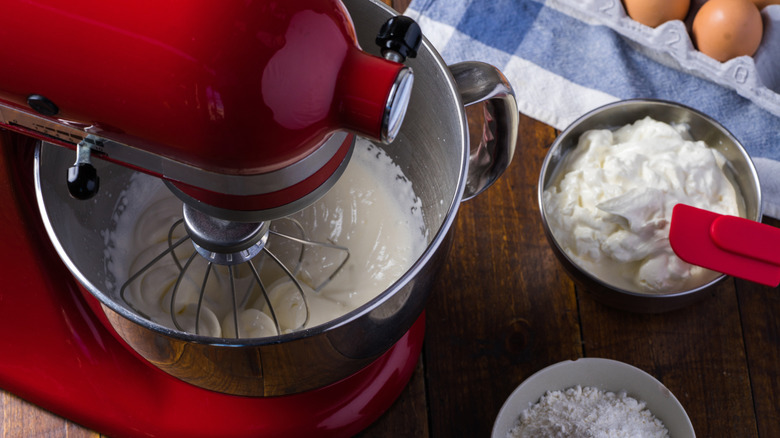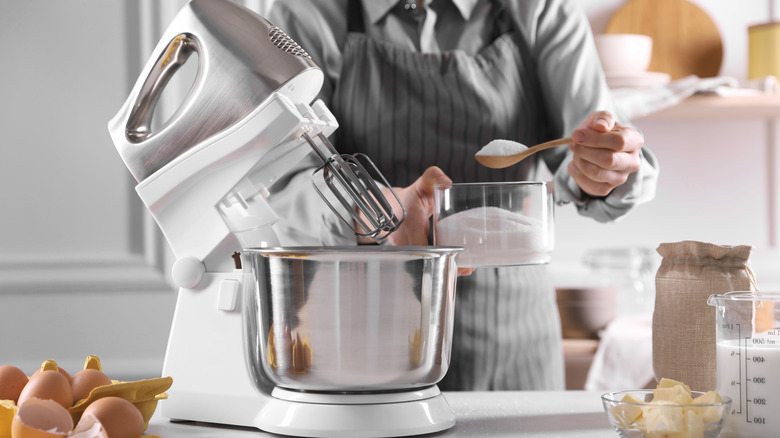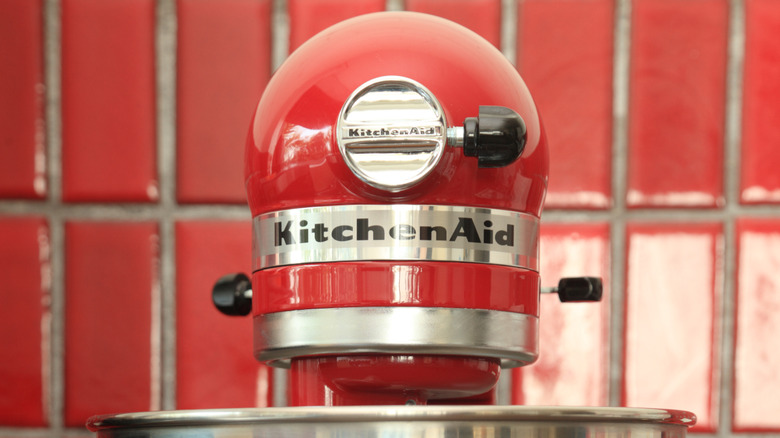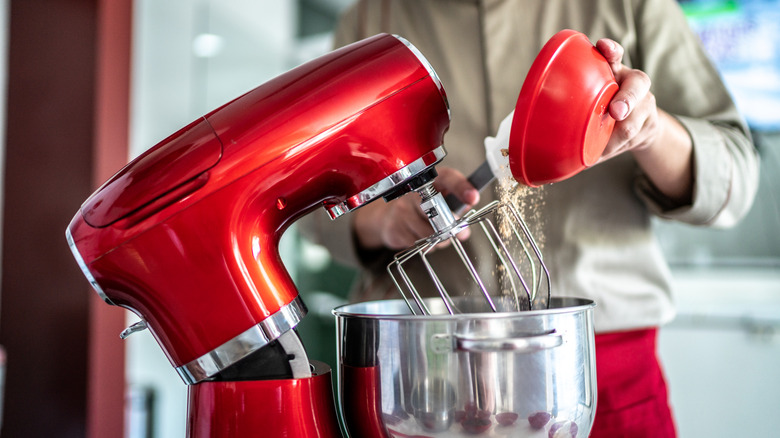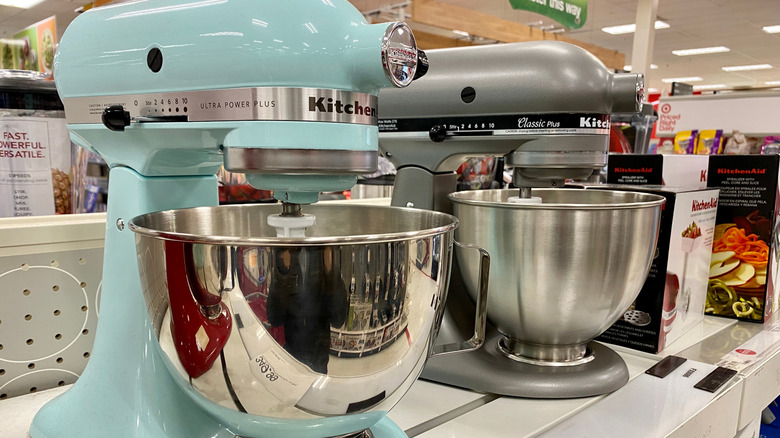Worth The Hype Or Overpriced: Are KitchenAid Stand Mixers Worth It?
We may receive a commission on purchases made from links.
You can likely find the name "KitchenAid" somewhere in your home. The 100-plus-year-old company makes everything from large appliances such as refrigerators and ranges to tabletop devices such as coffee makers and toasters. But there is one product with which the company is practically synonymous, so much so that people only have to say "my KitchenAid" and you probably know exactly which appliance they're referring to: the KitchenAid stand mixer.
We're sure you know the one. It's among the most purchased wedding gifts and on many a couple's registry. It comes in a rainbow of shades so striking that the catalog of all the product models resembles a Pantone color wheel. But is an appliance primarily used for baking really needed in every newlywed couple's home? And does it have to be a KitchenAid? As with most tabletop appliances, it depends on how (and how often) you'll use it.
Types of stand mixers
There are, generally, two types of stand mixers: tilt-head and bowl-lift. Tilt-head models let you move the head that houses the motor back so you can easily add ingredients as you mix. With bowl-lifts, the bowl is instead lifted up to the mixing attachments. Tilt-head mixers are usually better for smaller batches of food while bowl-lifts are usually better for larger batches.
One alternative to a stand mixer is a hand mixer. Hand mixers generally have one or two beater attachments that can be inserted into any bowl. Since you hold the mixer by hand, you have more control over where it goes, but the device can start to feel heavy; it's best for small batches that you only need to mix for a short time. Hand mixers are also easier to store, and you can buy some models for as little as $22. Stand mixers, whether made by KitchenAid or not, generally cost hundreds of dollars.
What makes a KitchenAid stand mixer special?
KitchenAid stand mixers are regularly rated the best stand mixer hands-down (pun intended) by culinary magazines, review sites, and shopping guides. The model at the top of most of these lists is the KitchenAid Artisan Series 5-quart tilt-head stand mixer for $450. Reviewers cite some of its simple features, such as the mixing bowl handle which makes the bowl easier to lift (especially when the ingredients are heavy) and the bowl's pouring shield, which you can add ingredients through to prevent messy splatters while mixing. KitchenAids also have excellent durability, with one Reddit user boasting a few years back that their KitchenAid has been running for nearly 25 years.
But the mixer does a lot more than just turn egg whites and sugar into meringue. Some of the things you probably didn't know your KitchenAid can do include kneading dough, pressing and cutting pasta ribbons, milling grains, and juicing fruits and vegetables. However, there are KitchenAid attachments you need to perform many of these functions, and some of them are more worthwhile than others; for example, although KitchenAid mixers often come with a standard dough hook, a spiral dough hook can make homemade bread almost effortless. This special dough hook costs $55, and that's one of the cheaper attachments; for comparison, you can also purchase a bundle that includes a food grinder and pasta press for $320.
Alternative stand mixer brands
The KitchenAid isn't the only stand mixer in town; there are plenty of alternatives that do the job for less money. But, if you want to stay in the same price range, one top pick is the Breville Bakery Chef for $450. Among the features it's been praised for are scrapers attached to the beaters that help fully incorporate ingredients (and make clean-up easier), a built-in timer, 12 speed settings, and an attached light that makes it easier to see what's in the bowl.
Less expensive but still-highly rated brands and models include the Cuisinart Precision Master for $250 and the Aucma stand mixer for $170. Some reviewers thought the Cuisinart performed as well as the KitchenAid, and liked that it has 12 speeds and an easier-to-use speed dial. Others said the Aucma performed as well as more expensive models despite having only six speeds, though noted that the mixer works best with small-to-medium batches. If only a KitchenAid will do, you can opt for the manufacturer's own certified refurbished models to save some money. Prices start at $200 for a six-quart model.
Should you buy a KitchenAid stand mixer?
With all this knowledge, the first questions to ask yourself before purchasing a KitchenAid — or any stand mixer — are still "do I bake and, if so, how often?" If you don't bake, then even the least-expensive model will sit on your counter unused or clutter your cupboards unnecessarily. Even if you were planning on making pasta with it or grinding meat, just buy a pasta maker or meat grinder instead. But, if you're an avid baker, a KitchenAid is undoubtedly the way to go given the strong reviews the brand gets year after year. As one Reddit user said, "It has been great and a worthwhile investment ... The more you use it the more you will try to find things to use it for."
If you only occasionally bake, you probably want to go for either a smaller KitchenAid or one of the less expensive brands. As an unenthusiastic baker said on Reddit, "It's worth it if you do larger batches of stuff or make bread. I find it useless for even making a standard batch of cookies because you have to constantly stop and scrape down the sides." Then again, if you like the status of having a KitchenAid on your counter, put it on your gift registry and hope for the best.
